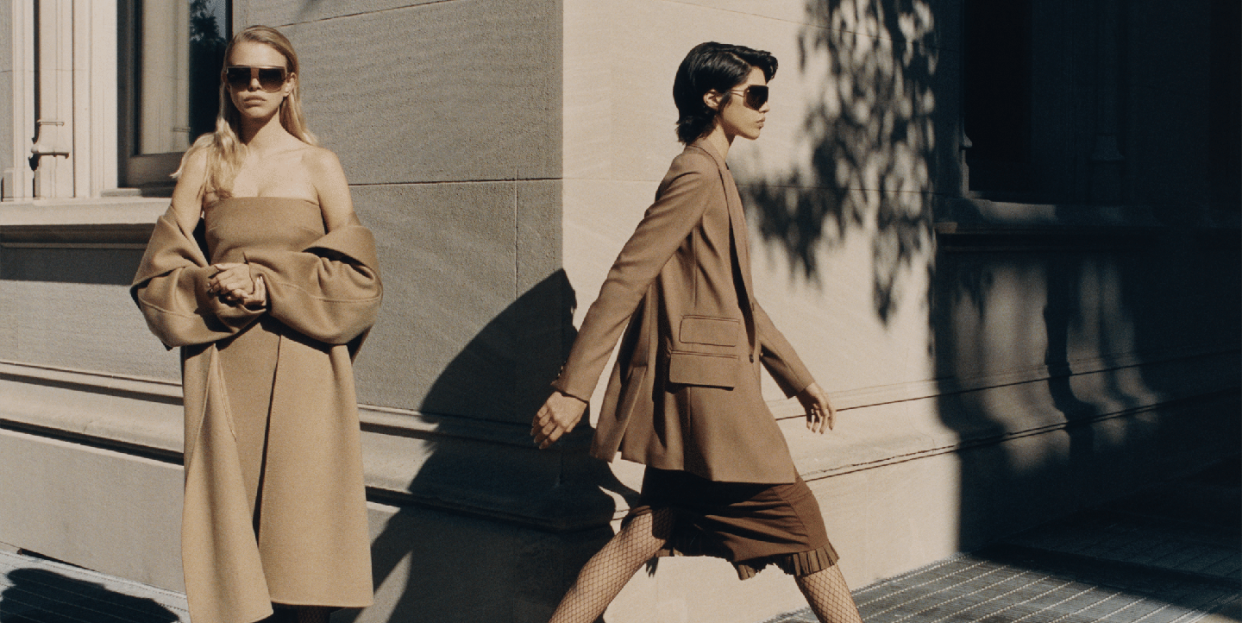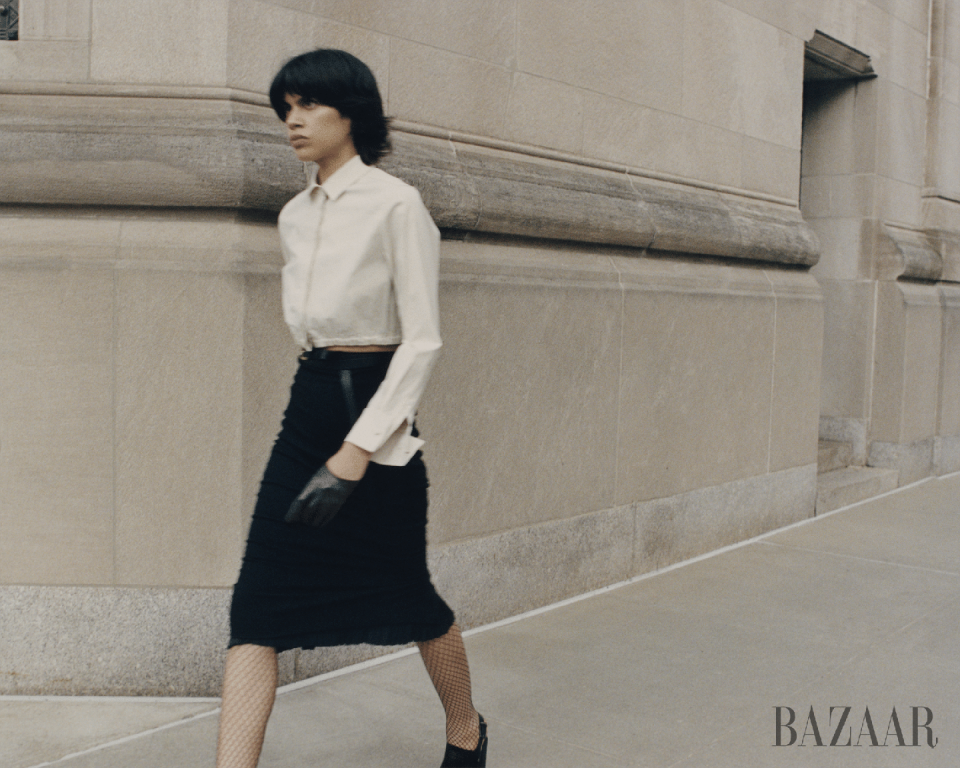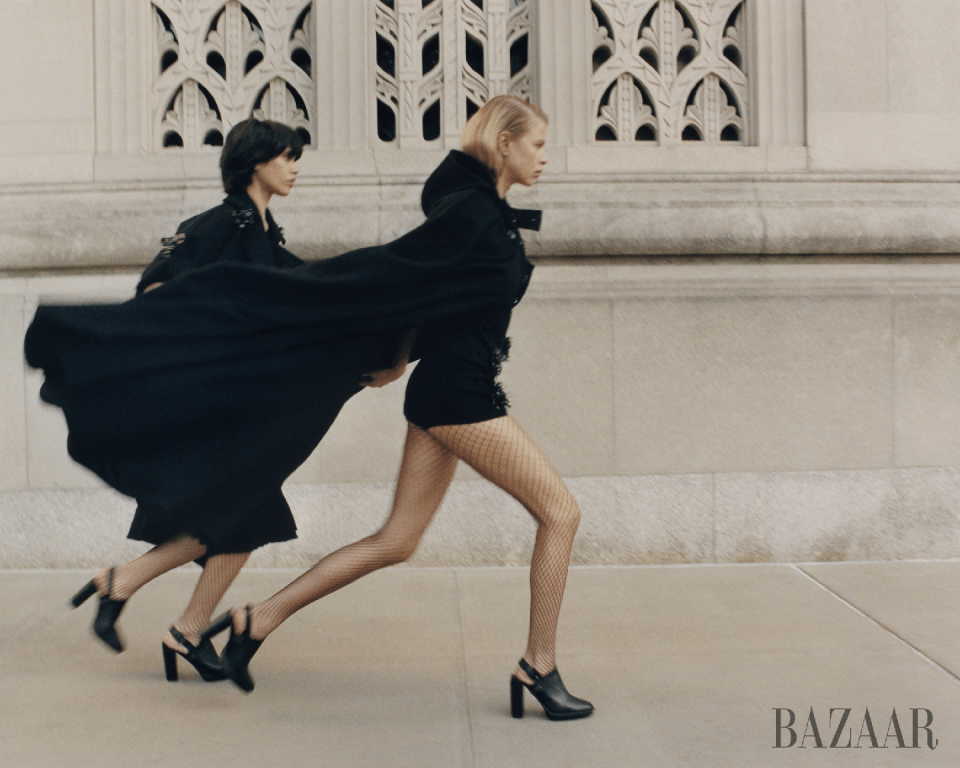Inside Max Mara’s Beautiful, Trend-Free Universe

In a world of mixed messages, the Italian brand Max Mara is uniquely synonymous with power. As Angelina Jolie evolved her image to include humanitarian work as well as her acting, she made Max Mara’s pencil skirts and wrap coats staples of her wardrobe. When Meghan Markle’s celebrity shifted from soundstage to world stage, she relied on an assortment of unfussy button-up silk blouses and mouthwateringly soft outerwear. And when Nancy Pelosi, soon to be the Speaker of the House, exited a contentious meeting at the White House with then-president Donald Trump in 2018, she was cocooned in a sleek red funnel-neck coat that gained viral acclaim as the “fire coat.”
These are clothes designed to empower and also recede behind the wearer in their crisp correctness, to ensure her image won’t be cluttered by any competing message from a fashion designer.
And this is the kind of clothing Max Mara makes. You will never see a Max Mara collection that’s in conversation with what’s happening at Gucci, Prada, or other luxury brands that inspire biannual changes in sleeves, hem lengths, and color palettes. You won’t spot the Max Mara logo anywhere but the tag of a garment. The brand does not build a world and invite you to participate in its fantasies; it sees the world that its woman—well-off, well-heeled, and well-positioned—lives in and designs for her reality.
Max Mara’s clothes imbue their wearer with a feeling of security, of confidence in her own power, a magic trick most directly associated with those aforementioned coats. Long a fashion-
insider status symbol, the wool and cashmere ones, in resolutely simple wrap shapes or sumptuous double-breasted cuts, are often compared to the Hermès Kelly bag or the Burberry trench coat because of how they serve as an emblem for the brand. Still, like the rest of Max Mara’s clothes, they are discreet, a kind of anonymous armor.
Max Mara has long been considered appropriate clothing for occasions that demand a bit of gravitas—like Jolie’s United Nations visits, or Markle’s royal appearances, or Pelosi’s showdown with Trump. But increasingly, its steadfast commitment to understatement, to putting the woman before the clothes, feels like something singular, even radical. In a fashion world dominated by sputtering trends and dizzying change, women find something respectful in Max Mara’s philosophy. While most brands strive to froth their customers up to buy their latest It bag or dress every six months, Max Mara has instead focused on subtle variations on classic wardrobe pieces with a commitment to quality. It isn’t necessary to buy a new coat every season because the design and the fabrication hold up; the coat will live in your closet for decades.
“You can’t even talk about fashion anymore,” says Ian Griffiths, Max Mara’s creative director, “because it doesn’t exist. It’s so fast that something is over before it’s even really happened. It’s all about individual choices. There is a sea of ideas out there, which is overwhelming. And I always think of Max Mara as being a rock in the sea. It represents lasting value. It’s clinging to something with meaning.”
Like many of Italy’s fashion businesses, Max Mara is family owned. In 1951, Achille Maramotti had the idea to mass-produce the kind of high-quality clothes that Italian and French couturiers were making. Throughout its half-century-plus history, Max Mara—named for an abbreviation of Maramotti’s surname and Max, a local character in his hometown of Reggio Emilia—has spawned a dizzying array of diffusion brands (Sportmax, Max&Co., Weekend Max Mara, ’S Max Mara …). But the allure of the house’s runway clothes, shown twice a year at Milan Fashion Week and in the type of annual traveling “resort” collection that is now common among big luxury players, remains intact.

Also unchanged: Max Mara’s emphasis on the brand over its designer. The British-born Griffiths arrived at Max Mara in 1987, as a recent fashion graduate and passionate club kid, and worked his way up to the role of creative director. But it’s only in the past decade that he has even spoken on behalf of the brand. This is no Martin Margiela circus act, in which Griffiths is playing coy to cultivate mystery. He simply understands that his job is to emphasize the customer—the woman—rather than himself.
When we meet in June in a Lisbon hotel suite that’s serving as the brand’s press war room, just before the 2023 Resort show, Griffiths tells me he keeps a pinboard in his office back in Italy with images of people who perennially inspire Max Mara’s collections: Marilyn Monroe, Dorothy Parker, Grace Jones. And David Bowie. Yes, the unofficial muse of a brand known for unchanging classics is Mr. Ch-ch-ch-changes himself. “David Bowie deserves his place on that board for what he did in opening people’s minds and for being able to constantly reinvent himself but stay true to who he was,” Griffiths says.
That’s how Griffiths tries to approach designing for Max Mara; fashion requires constant newness, but there is something solid and unchanging at the core. “It’s this sense of reinvention, but there’s this true essence to every Bowie album,” he explains. Each Bowie album still sounds like Bowie. “He never changed his message, [though] he muddled and clouded and distorted it, and he pushed it.”
The three-day resort show, a suave affair, was staged within the gardens among the pools of the Calouste Gulbenkian Museum, one of Lisbon’s marquee arts institutions. Mention Lisbon, Griffiths noticed, and people would say, “Oh! I’ve always wanted to go there.” It’s become a magnet for young Europeans relocating from more expensive cities and a hub of contemporary culture and design. On a research trip, he discovered Natália Correia, a leftist writer who lit up Lisbon’s society and intelligentsia throughout the 1960s and ’70s with her salons, which drew intellectuals like Graham Greene and Eugène Ionesco. (There was also the matter that “she more than dabbled in erotic poetry,” as Griffiths puts it, which is a pursuit that got her a prison sentence.)
Behind us is a rack of clothes from the resort collection: pencil skirts with pleated underskirts and expertly tailored shirtdresses and jewel-tone plissé gowns. You can see the flavor of Correia once he describes it, but all of the clothes are quintessentially Max Mara. (This is actually a tough nut to crack. There’s a running joke on Instagram that if you post a runway look from many of the top houses without the brand name, you can’t tell the difference. But it’s clear what’s Max Mara.) “I mean, I’m not designing a costume drama,” Griffiths says. “I have to be careful not to get so drawn into the story that the story drowns out the bigger story, which is the story of the Max Mara woman. It’s an influence as opposed to a theme.” The classic pencil skirt becomes curvier, influenced by the way he saw that Correia wore them. Or the coat becomes more kimono-like, its sleeves short and soigné.
“Each piece that we design is thought through to stand alone and integrate within a wardrobe that may contain pieces of Max Mara from other collections from whenever,” Griffiths says. “Whatever you buy from Max Mara needs to work now and in the future.” This approach, that you have a concisely pulled-together wardrobe of gorgeous and occasionally extravagant building blocks that you wear for decades and thoughtfully augment, is exactly the philosophy that many brands are flailing to promote now in the name of sustainability. In that light, you might say that sustainable shopping has always been Max Mara’s thing.
WHEN A WOMAN PUTS ON CLOTHING, she does a kind of dance: How much of the look is hers, and how much is someone else’s? The pull of fashion—of runway styles and currents, of designers’ ideas and concepts—has never been stronger, and the idea of being a fashion victim is essentially passé. Embodying a designer’s runway vision off the runway has never been more accepted or appealing. And wearing clothes that are trendy, that are clearly the product of designer diktats, makes a woman into an emblem of her era, an avatar of her time. This is one of fashion’s great pleasures, and it is a pleasure that perhaps more women than ever are indulging in.
But of course, the fashion cycle has sped up immensely, and many women find that exhausting. “I can only describe today’s trends as polarizing and hyperspecific, which can be great for individuality if you already have a sense of self, but it can also mark such a specific time period, up to the month and year,” says Cortne Bonilla, a 29-year-old writer who gravitates toward classic styles. “This is such an Aries thing to say, but I really can’t be bothered to go into my closet and feel conflicted,” she continues. She prefers clothes in which “the DNA of the brand is focused more on sensibilities rather than aesthetics. Classic is quality. ‘Timeless’ can’t be pinpointed to April 2022.”

The stasis of Max Mara creates a different kind of appeal. “I’ve always thought that what I can do for any woman is give her, allow her to have, these things, these items, which help her to develop a sense of power,” says Griffiths. “Which make
her feel better, which make her feel more ready to take on things that maybe are not so pleasant.”
The formula that Griffiths uses—choosing an inspiring figure to animate an established set of house codes two or three times a year—is the same one that fashion brands have relied on since the 1980s. But maybe what makes Max Mara’s application of it so effective is that, while other brands have ramped up and accelerated that system, creating fashion for fashion’s sake, Max Mara keeps it in control. The woman is always in the front of the picture.
Rachael Bedard, a physician and writer, procured a navy belted Max Mara coat this year. “I have always felt that dressing ought to express one’s intelligence, that taste is a mixture of a good eye, a good mind, and a good sense of humor,” she says. “I am most drawn to clothing that has a point of view, but that doesn’t actually mean noisy clothing.”
Clothing can play a supporting role when it’s built to last. Erica Wright, the 31-year-old U.K.-based founder of the fashion tech start-up Sourcewhere, grew up seeing her aunt wear the same few Max Mara pieces over and over. She now wears the brand herself, but she has also begun to see the influence of Max Mara’s emphasis on defiant untrendiness, or design over fashion, in newer brands like Totême and Khaite. “It’s timeless,” Wright says. “It’s useful.”
“It does feel ‘antifashion’ in the sense that it makes no statement about anything, not even the wearer,” adds Bedard, who is 40.
“I am not expressing myself through this coat. I wear this coat and feel graceful and quiet.” Even Jolie uses the Max Mara wardrobe this way. In addition to wearing the clothes to the UN, she often wraps herself in the brand’s coats to run errands or take her kids out to lunch.
Timelessness, of course, can imply a sense of conservatism. And yet what women increasingly see in a brand like Max Mara is quite the opposite. It is a refuge from the noise of trends, the constant sense of self-reinvention inherent in brands that dominate social media and, most of all, the declining quality of clothing that sells even at designer prices. “They will not compromise on where it’s manufactured, and the materials don’t differ as the decades go on,” Wright says. “There’s a huge amount of respect [for the customer] in saying, you know, ‘We’ve done this very well for a very long time, and we’re not prepared to shift that.’ ”
Griffiths thinks about his shows as a mirror for these women. “I’m saying, ‘Can you see yourself in this picture? Can you imagine yourself?’ I want people to relate to what they see.” Most fashion shows aren’t like that, he acknowledges, and many brands shouldn’t be like that. “But to me, it’s that engagement with a woman—a woman I know quite well, a person I know quite well, because I’ve been thinking about her for 35 years.”
All clothing and accessories, MAX MARA.
Models: Valeria Gomez and Luna Hauswirt; Hair: Junya Nakashima for Oribe; Makeup: Homa Safar; Manicures: Aja Walton for Essie.
This article originally appeared in the December 2022 / January 2023 issue of Harper's BAZAAR, available on newsstands December 6.
GET THE LATEST ISSUE OF BAZAAR
You Might Also Like

